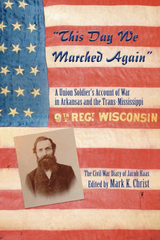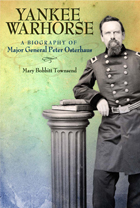2 books about German American soldiers

"This Day We Marched Again"
A Union Soldier's Account of War in Arkansas and the Trans-Mississippi
Mark K. Christ
Butler Center for Arkansas Studies, 2014
A testament to the valor and determination of a common soldier On September 17, 1861, twenty-two-year-old Jacob Haas enlisted in the Sheboygan Tigers, a company of German immigrants that became Company A of the Ninth Wisconsin Infantry Regiment. Over the next three years, Haas and his comrades marched thousands of miles and saw service in Arkansas, Kansas, Missouri, and the Indian Territory, including pitched battles at Newtonia, Missouri, and Jenkins’ Ferry, Arkansas. Haas describes the war from the perspective of a private soldier and an immigrant as he marches through scorching summers and brutally cold winters to fight in some of the most savage combat in the west. His diary shows us an extraordinary story of the valor and determination of a volunteer soldier. Though his health was ruined by war, Haas voiced no regrets for the price he paid to fight for his adopted country.
[more]

Yankee Warhorse
A Biography of Major General Peter Osterhaus
Mary Bobbit Townsend
University of Missouri Press, 2010
A German-born Union officer in the American Civil War, Maj. Gen. Peter Osterhaus served from the first clash in the western theater until the final surrender of the war. Osterhaus made a name for himself within the army as an energetic and resourceful commander who led his men from the front. He was one of the last surviving Union major general and military governor of Mississippi in the early days of Reconstruction.
This first full-length study of the officer documents how, despite his meteoric military career, his accomplishments were underreported even in his own day and often misrepresented in the historical record. Mary Bobbitt Townsend corrects previous errors about his life and offers new insights into his contributions to major turning points in the war at Vicksburg, Chattanooga, and Atlanta, as well as other battles.
Townsend draws on battle reports not found in the Official Records, on personal papers, and on other nonpublished material to examine Osterhaus’s part in the major battles in the West as well as in minor engagements. She tells how he came into his own in the Vicksburg campaign and proved himself through skill with artillery, expertise in intelligence gathering, and taking the lead in hostile territory—blazing the trail down the west side of the river for the entire Union army and then covering Grant’s back for a month during the siege. At Chattanooga, Osterhaus helped Joe Hooker strategize the rout at Lookout Mountain; at Atlanta, he led the Fifteenth Corps, the largest of the four corps making Sherman's March to the Sea. Townsend also documents his contributions in the battles of Wilson's Creek, Pea Ridge, Arkansas Post, Port Gibson, Ringgold Gap, and Resaca and shows that he played a crucial role in Canby’s Mobile Bay operations at the end of the war.
In addition to reporting Osterhaus’s wartime experiences, Townsend describes his experiences as a leader in the 1848–1849 Rebellion in his native Germany, his frustration during his term as Mississippi’s governor, and his stint as U.S. consul to France during the Franco-Prussian War.
Osterhaus stood out from other volunteer officers in his understanding of tactics and logistics, even though his careful field preparation led to criticism by historians that he was unduly cautious in battle. Yankee Warhorse sets the record straight on this important Civil War general as it opens a new window on the war in the West.
[more]
READERS
Browse our collection.
PUBLISHERS
See BiblioVault's publisher services.
STUDENT SERVICES
Files for college accessibility offices.
UChicago Accessibility Resources
home | accessibility | search | about | contact us
BiblioVault ® 2001 - 2024
The University of Chicago Press









